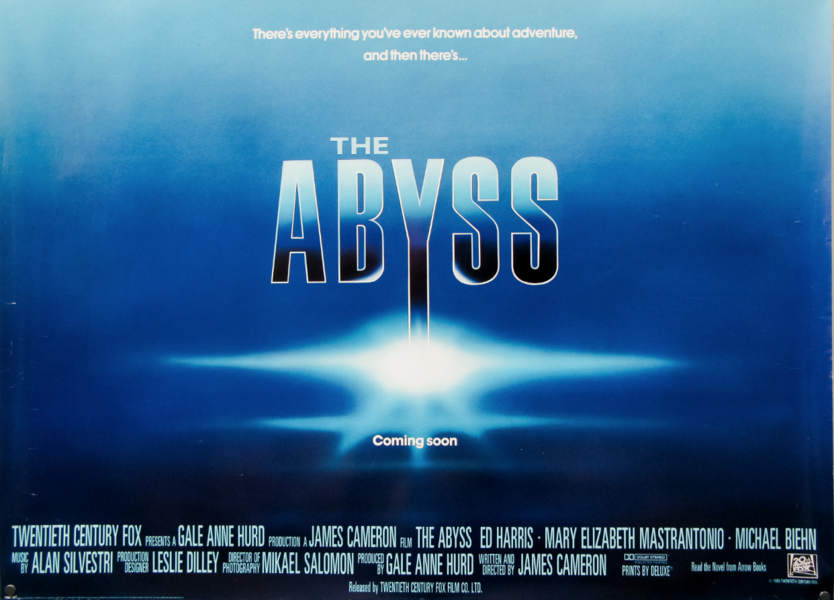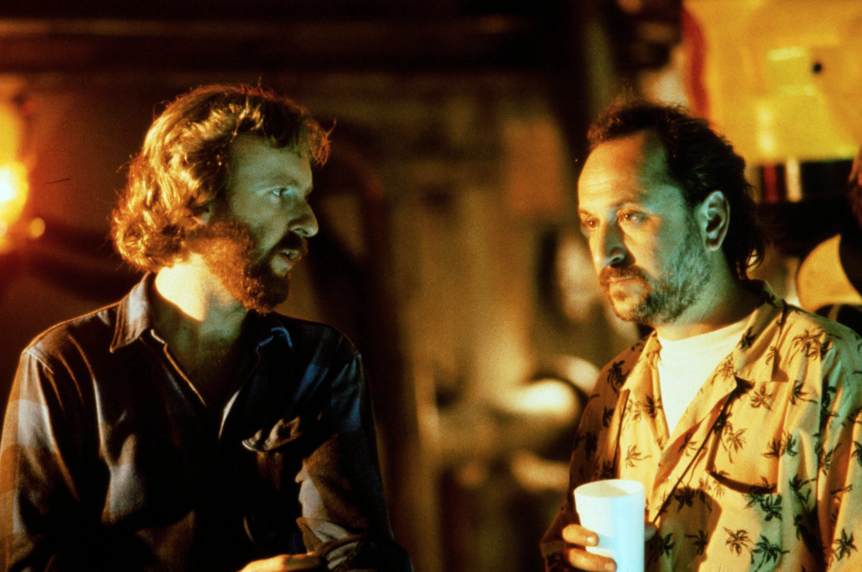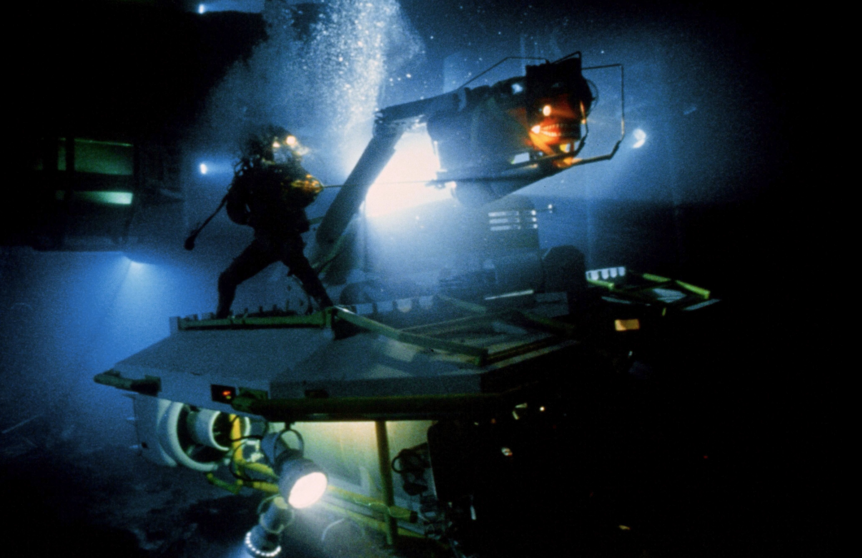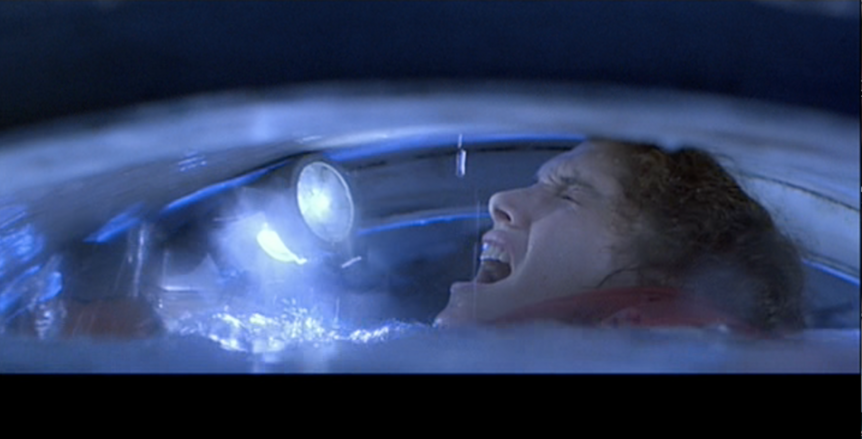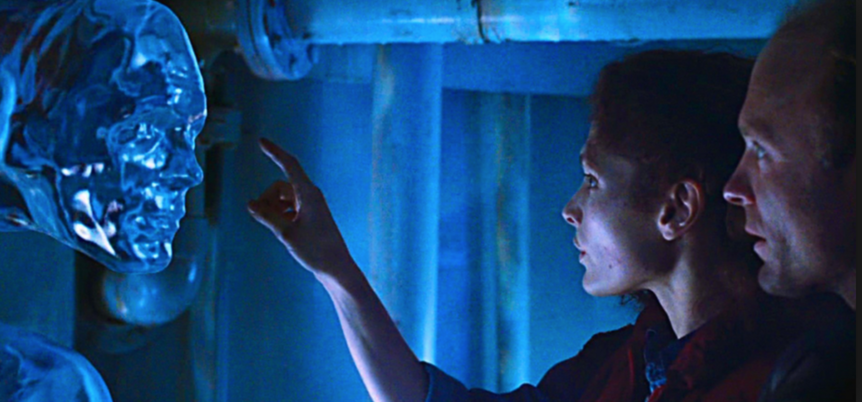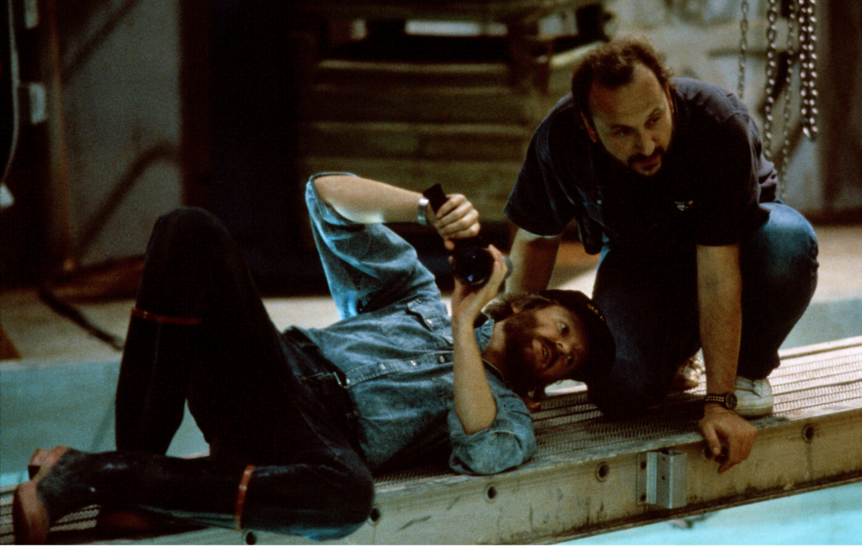Create a free profile to get unlimited access to exclusive videos, sweepstakes, and more!
The Abyss at 30: Cinematographer Mikael Salomon on water-logged tech challenges and on-set electrocution
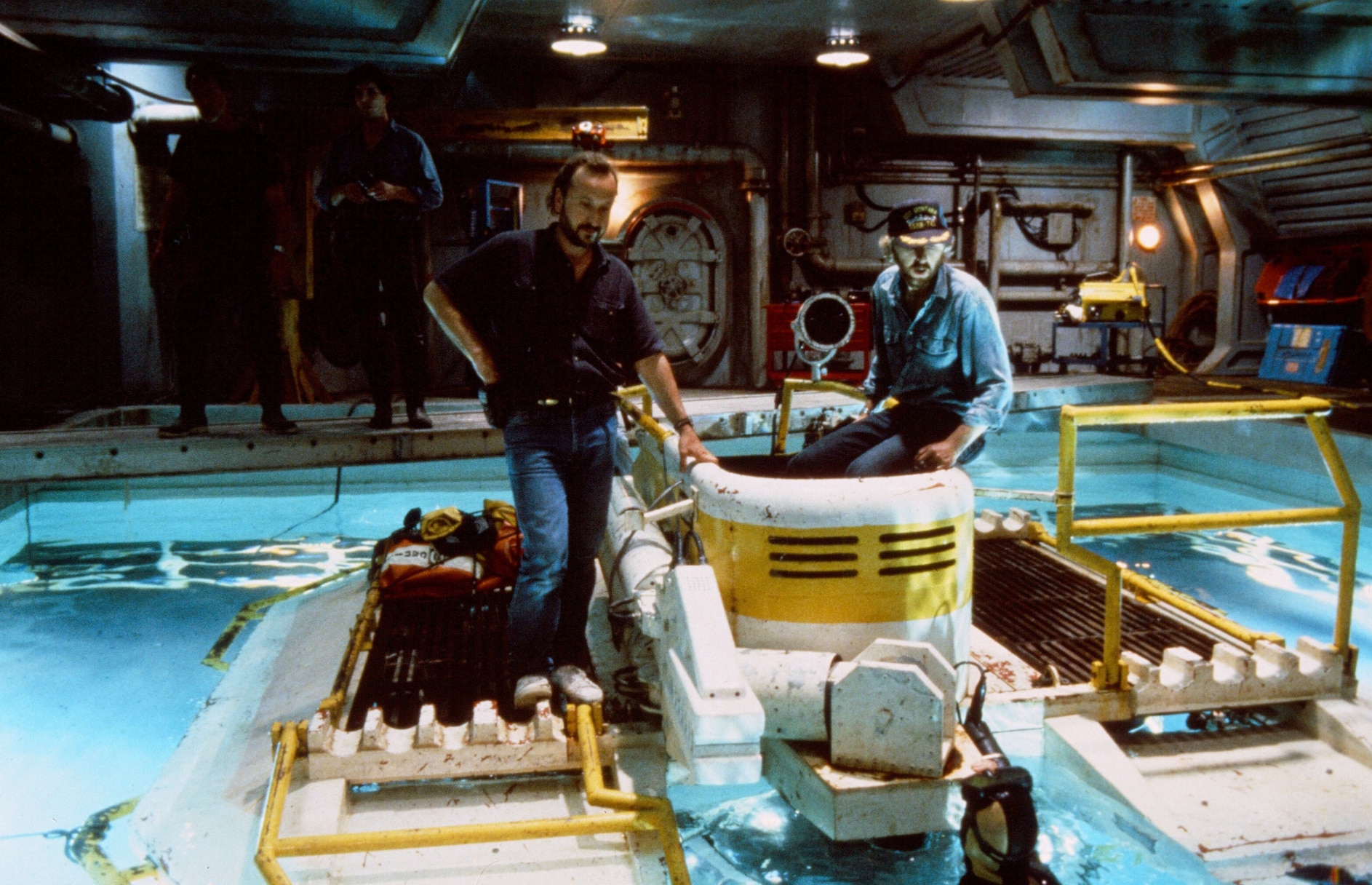
Director James Cameron's underwater sci-fi spectacle The Abyss made a substantial splash at the box office 30 years ago today. This wildly original story — a roughneck gang of deep-sea divers encounters luminescent alien beings while attempting to rescue crewmen aboard a downed nuclear submarine — premiered on August 9, 1989, with considerable fanfare.
This big-budget odyssey starring Ed Harris, Mary Elizabeth Mastrantonio, and Michael Biehn has since been branded the most difficult film to have shot in cinematic history, one that also helped usher in a new age of digital special effects. Cameron's $70 million epic was just his third major Hollywood movie, following right after the roaring success of 1986's Aliens.
Shot in the world's largest underwater film set, which was constructed in an abandoned nuclear power plant in South Carolina, and completed after a grueling six-month shoot, The Abyss stands apart as a grand achievement in filmmaking and still looks as fresh today as it did three decades ago.
To deliver a distinctive visual style to the impossible project, Cameron hired Danish-born cinematographer Mikael Salomon (Backdraft, Far and Away), now a two-time Academy Award nominee (for The Abyss and Backdraft) and an Emmy Award-winning director for his work on HBO's Band of Brothers.
SYFY WIRE took the plunge and spoke with Salomon on his innovative camerawork for The Abyss on the occasion of the film's 30th anniversary. We learned about how he endured the torturous shooting schedule and what it was like working with a young James Cameron, as well as the ins and outs of eating well in South Carolina and exactly which final version of the movie he loves best.
With the 30th anniversary of The Abyss here, what stands apart most when you reflect back on the making of it?
First of all, I cannot believe it was 30 years ago. It feels like it was not that long ago, because it's fresh in my mind. It was a huge experience in many ways and a very complicated shoot — but also very rewarding because it was so different from anything else I'd done.
I'd done a lot of European movies and did a small movie in Virginia called Zelly and Me with Isabella Rossellini. My agent called me up and said I needed to go to Fox and read a script. It was incredibly exciting, but I asked, "How is this going to be pulled off?" So Jim [Cameron] and I had a nice conversation, and eventually I was told I had the job.
What were the techniques used to give the film such a saturated, glossy look?
I used a lot of indirect and bounce lighting. One of the problems is that Jim wanted to shoot anamorphic, and I told him that with the film speed of 100 ASA, there's no way we could shoot underwater anamorphic. I showed him a format I'd just used while shooting a movie in Denmark. We didn't call it Super 35 at the time, but that's what it was. Clairmont Camera modified a camera and we shot a test and he said, "Let's do it." That's how Super 35 started in the U.S. That way I could use a spherical lens, which is much faster and you can shoot almost wide open.
Nearly every shot was an invention, and it was a fun challenge. We did blue screen underwater. We did rear projection underwater, which no one had done before. There was a lot of miniature model work incorporated into the rear projection.
Ed Harris' suit when he goes down for the final dive, it arrived the day we were supposed to shoot and there were no lights in it. This is before LED lights, but I'd gotten ahold of some fiber optics. We put a battery pack in his backpack, then ran the lights up to his helmet to where the ends of the optical strands came out. All that we did in a day because we had to shoot.
Today, you just pop some waterproof LED light in there. It would have been so much easier!
What were some of the most challenging sequences to film?
It's hard to know where to begin. [Laughs]
There's a scene where the crane is coming down and crashing. The crane was shot as a model, but then, looking out the window, we shot it as a plate on 65 MM at high speed, but that plate was supposed to be rear-projected outside the windows of the command module when they look out and see it hit the ground. The problem was we had no time, and when the plate arrived from the lab, they loaded it up and it was completely green. Jim asked me what I was going to do about it. So I had to put green filters on all the lights and we shot the whole thing in green, and then pulled the green out in post at the lab. And it worked!
Another tough thing was all the stuff inside the module where there's panic and everyone is running back and forth. I was just running with a little Arri-C camera with an 18 MM lens on it and a 100-foot mag, because that's all there was room for. I was just running with the actors and had a little transmitter so Jim could see the image on the monitor. I couldn't see anything. I got in great shape, but that was mainly because of all the swimming.
What was discussed between you and James Cameron as to the style, tone, and colors of The Abyss?
There weren't really any references at all; there were no predecessors. There were people who had shot underwater, of course, but nothing in that style. It was sort of a space opera in many ways, and he did show me Aliens — which he was very proud of — and some of the visual effects and the tricks he had done.
There's a scene in which the dome glass cracks because Michael Biehn's vehicle is under so much pressure. We mirrored it in by putting a piece of household foil on a strip over on the right, then we put a light on it and put a flag in front of it. Just when it cracks, I reveal it. That's just the piece of foil reflected in the dome.
What really helps is the sound! It goes "crack" and people swear they saw the dome crack, but it doesn't, it's just a reflection.
Do you have a favorite scene in The Abyss that you filmed?
On the first day of shooting, we began in one of the tanks because the main set wasn't ready. We started shooting the scene where Mary Elizabeth drowns. That was a steel hull, but it was on a crane so we could lower it into the water to simulate the level rising. I was shooting hand-held with a non-underwater camera and there was a lot of water spraying around in there. I got an electric shock and it went straight through my right arm, up into the camera, and down into the water on the other side and took out all the electronics in the camera.
So we got a new camera. But there's still a lot of water spraying around, and my camera assistant was ready with a piece of suede to get drops off the lens. After a two-second pause his hand came up to take the drops off, but if you look at the movie, Jim didn't cut that out. It's incredibly out of focus, but I was pleading with Jim to cut it out, but he said nobody is going to notice it. We saw it the other day at a 70 MM screening at the Academy and I was nudging my wife as it came, but Jim was right, nobody ever noticed it.
What were the special considerations or lighting issues needed during the famous water tentacle scene?
Industrial Light & Magic's Dennis Muren was there and we shot all that on VistaVision, which is 35 MM running horizontally. There wasn't anything there, so we made a dummy and assistants carried it in the door and lit it. I needed interactive lighting on the walls, so I put trays with broken mirrors on the floor, then filled water on top. Then we agitated the water so we got that effect on the actors and the walls.
We rehearsed with the dummy, but when we shot it we couldn't have it — but they knew where to look. When they cut the sequence together, I think every frame took eight hours to render on the computer. That was the kind of computer power they were working with in those days.
When the water tentacle retracts and disappears back into the ocean, we had a big oil drum filled with sand that we released from above to make that splash. It was a miracle nobody got hurt on that shoot. The set was four stories deep and for the end scenes we took the water out, and it was so slippery and made out of steel and people were running around on it. It was crazy.
How was it working with the cast?
The cast were all troupers. They would wait sometimes for two weeks to get on. There was nothing for them to do. I didn't want to be in their shoes sitting around in a hotel room in a little town in South Carolina. Fine dining there was Jack in the Box. We were there for six months until we moved to San Pedro here in Los Angeles. Being there for six months, that was brutal, for all of us.
What is the status of a Blu-ray or 4K remaster of The Abyss, and will you be involved in the process?
I was involved a bit, but that was several years ago. There is an HD master and Jim said it's beautiful, but for some reason it was never released. It's probably 2K now because it was done a couple years ago. I don't think Jim has the time to deal with it, frankly.
Which version do you prefer, the original Director's Cut or the Special Extended Edition?
Jim only had final cut if he kept the movie under two hours, but then he made the extended cut, and that is the real director's cut, and that I far prefer.
There's much more to the story, and it makes sense with the tidal waves. I really didn't like the part where the whole alien craft comes up from the bottom with the ships on top; it looks like an inverted ashtray from the '60s. I asked him if we could please reshoot that, but he said, "No, we have no time, we have to release it now." So he put some diffusion on it and I said, "Oh, God."
Besides your crew bomber jacket, did you keep any props, costumes, or mementos from the shoot?
What I do have is my old light meter. Nobody had underwater light meters, so I had the special effects guy build me a housing for it, and I still have that. It was actually on display at some museum at one time, but they sent it back to me. That's really the only thing I kept from the show, except my wife, of course!
